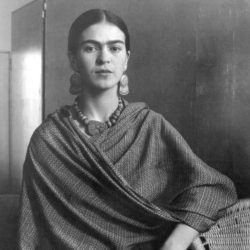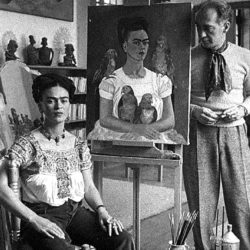
Many aspects of Frida Kahlo have been studied, pondered and admired. From her art, politics, love life, travails, and many others. A singular aspect of Frida Kahlo and her identity was her dress. Frida used dress consciously in the creation of her identity. Through dress, she crafted her image, displaying her cultural heritage from both Europe and Mexico. Who can imagine Frida Kahlo without visioning her Tehuana dress, the dress and region she most often adorned herself in, particularly for photos. But there were many others, from her “tomicoton” of Hueyapan, Puebla, her beautiful rebozos from Central Mexico, her Mazatec dress from Oaxaca and more. On this journey, we’ll explore how Frida used dress in the creation of her identity, and we’ll travel to some of the regions and communities of Mexico to meet the artisans, who to this day continue the legacy of hand crafting ethnographic clothing, an intimate expression of cultural identity.


Day One, Arrive Mexico City, Welcome Meet and Greet Reception and Fiesta Mexicana Welcome Dinner! (D)
You will be met at the airport to transfer to our charming hotel. After freshening up, we’ll enjoy a fun welcome, “Fiesta Mexicana” dinner to savor some of Mexico’s most traditional and beloved dishes, and some of Frida’s favorites.
Day Two, Morning Lecture on the Dress of Frida, Frida Kahlo Museum and Coyoacan, Museo Dolores Olmedo and Floating Gardens! (B, L)
We’ll begin our day with a breakfast presentation on Frida’s dress, through photographs and recently found personal items. We’ll learn how Frida used dress to create her identity and “Mexicanidad”. While she was often most associated with Mexican indigenous dress, Frida also recalled her European roots and family heritage in her dress. After all, Frida was BOTH; and so is Mexico!
Following, we’ll travel to Coyoacan, the neighborhood where Frida grew up. We’ll begin with a welcome visit to the Frida Kahlo Museum, or “Blue House”, before we enjoy our own private time with Frida’s art, photographs, letters, clothing, artifacts and more. Leaving the Museum, we’ll stroll in Coyoacan, get a delicious snack (a tradition in Mexico is to eat in markets and from street vendors, and something Frida loved to do with Diego). Then, we’ll travel to Xochimilco to visit the Dolores Olmedo Museum, where the largest collection of Diego and Frida paintings are held. Our day will end with a fun and relaxing ride on the “trajinera” boats in the “chinampas” of Xochimilco, much as Frida loved to do!
Day Three, Museum of Modern Art, National Museum of Anthropology, Transfer to the Isthmus of Tehuantepec (B, L)
Our day begins at the Museum of Modern Art to see the wonderful permanent collection here, and the masterpiece considered the Mona Lisa of Mexico, “The Two Fridas”, by Frida Kahlo. This painting is on a much larger scale than most of her works, which were smaller and considered more intimate. It almost shouts to the world, “I come from two cultures, and this is my dual identity”, just as Mexico has two identities and blend of cultures, or “mestizaje”. After our viewing, we’ll cross the Reforma to view special rooms at the National Museum of Anthropology, linking Mexico’s ancient, pre-Hispanic past to today’s living cultures of Mexico. In the early evening, we’ll board our flight, directly to the Isthmus of Tehuantepec.
Day Four, Isthmus Dress and Techniques, Evening Event, Fashion Show and History/Evolution of “Traje”, Overnight Isthmus (B, D)
Today we begin our immersion in the singular cultural universe of the Isthmus of Tehuantepec, a land of mangoes, strong and enterprising women, the famed Zandunga dance, and beautiful “traje” or dress. A matriarchal society, the women are strong, earn the money, control the purse strings and love to spend it on what many women do: their dress. But here, the dress IS their identity. Known as “Istmenas”, the women from the Isthmus wear a cultural passport. By seeing them in the markets, on the streets at home or in any part of the world, they are identified largely through their clothing. Frida’s mother Matilde was from the Isthmus. And, as the dress here is gorgeous, embellished with grand embroidery in hand embroidered flowers (imagery likely of Asian origin), geometric “cadenilla” chain stitch and floral “gancho” or hook technique, Frida loved to don this dress. The elements of the dress or “traje” consist of a huipil (the top), enagua or rabona (skirt), lace underskirt or “refajo”, a lace head dress called “huipil grande” or “esplandor”. Frida was photographed wearing Istmena dress, and she painted self-portraits of her wearing this dress. It is even featured in her painting, “My Dress Hangs There”, likely a statement of her being caught in the wind, between two worlds, Mexico and the United States, when she and Diego traveled there.
Today, we’ll learn of the various embroidery techniques, visiting artisans; we’ll enjoy a regional lunch and we’ll view collection pieces. In the evening, we’ll attend a Fashion Show of Regional Dress through time. We’ll close the evening with a dance, to the famed “Zandunga” rhythm, and a closing reception.
Day Five, Morning visit to Juchitan Market and Artisans, School, Overnight Isthmus (B, L)
Today we’ll travel to nearby Juchitan to meet with artisans who will demonstrate the three primary techniques used to embellish the beautiful huipiles from the Isthmus; hand embroidery, chain stitch with a machine, and a hook/punch technique. We’ll spend time at a special school that has recently opened its doors to teach younger generations the art of the “cadenilla” machine stitching; and art form that is at risk of disappearing. In the afternoon, we’ll visit the new Juchitan market (rebuilt after the devastating earthquakes of 2017. Here, we can purchase our last to huipiles, hair accessories, jewelry, etc. before we leave the region.
Day Six, Oaxaca City, Drive to Oaxaca City: Stop for lunch and natural dye demo in Teotitlan del Valle, Welcome Dinner, Oaxaca City (B, L)
Today we make our way to Oaxaca’s Central Valleys, stopping in Teotitlan del Valle, then in Oaxaca City. In Teotitlan del Valle, we’ll meet with our Zapotec weaver and dyer friends, who will give of a presentation and demo of their use of their natural dyes, an ancient and living practice in their art and community. Saying goodbye, we’ll arrive in Oaxaca City, check into our hotel and rest up before our dinner together, and a city and region, known for its cuisine.
Day Seven, Southern Craft Route, Ocotlan (B, L)
Today we’ll travel in the Southern Valley of Oaxaca’s Central Valleys in what is known as “the craft route”. We’ll begin in Ocotlan, a Zapotec town made famous by beloved painter, Rodolfo Morales. We’ll see the buildings and architecture he lovingly restored with money from the sale of his artwork, we’ll visit the “mercado” and make a stop at the famed Aguilar Sisters, who make charming collectable clay figurines in the likes of famous figures and guess who…Frida. We’ll then stop in San Antonino Castillo Velasco to visit the women who embroider the fine flowers and pansies on the blusas, admired and worn internationally in the 1960’s. We stop for a delicious lunch at La Azuzena, visit the backstrap loom weavers of Santo Tomas Jalieza, pay a visit to the Museum of Popular Art of Oaxaca, before returning home to rest and relax before our farewell dinner in Oaxaca City.
Day eight, Transfers to the OAX, Oaxaca airport (B)

01

02

03

04

05

06

07

08

09

10

11

12

13

14

15

16